
| ICE Case Studies
|
Ethnic Conflict and Natural Resources Xinjiang, China ICE Research Team |
I.
Case Background |

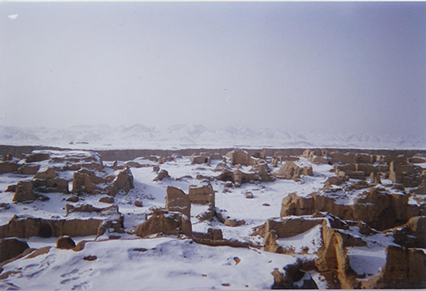 |
|
Ancient Ruins of Jiaohe City Xinjiang, China |
The Muslim Uyghurs are an ethnic minority in Xinjiang, the most western province of China. Particularly since the Communist takeover of the region in 1949, the Uyghurs have experienced religious and cultural persecution by the Han Chinese. With the discovery of oil and other natural resources in the region, the Han Chinese are now flooding into the region in an effort to exploit the resources. This influx of people has intensified the already tenuous relationship between the Han Chinese and the Uyghurs over their religious, cultural and social differences. Furthermore, the influx of people has lead to not only the extraction of resources but the over-cultivation of land and over-use of precious water resources in the area. As a result, the Uyghurs have strengthened their own campaign, sometimes resorting to violence, in an effort to reclaim their land to halt the religious and political persecution and, in extremist cases, to establish their own, independent Uyghur state.
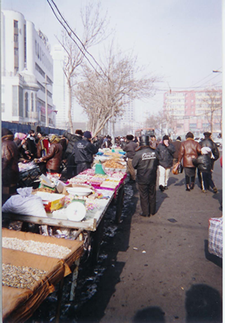 |
| Street Market Urumqi, China |
 |
| Muslim Mosque Urumqi, China |
Historical Relationship
Throughout various periods in history, the Uyghurs have experienced tastes of
independence, the independent republic of East Turkistan, for a short time.
However the Han insist that the same area was in fact settled by the Chinese
over 2,000 years ago. As a result of the historical disparities, disagreements
and hostilities over economic, political and cultural issues have plagued the
region up through its modern history.
Though the ethnic origin of the Uyghurs has been traced to the Uyghur Empire
in Northwestern Mongolia (744-840 C.E.) it is believed that the modern Uyghurs
have only existed since the mid-1930s (when the Chinese government defined the
modern Uyghurs as ‘oasis-dwelling Muslims of Xinjiang’s Tarim Basin).
That from 1450-1935 the term ‘Uyghur’ essentially went ‘unused’
does not mean that the people disappeared. In 1931 the Chinese government attempted
to manipulate the hereditary leadership in Xinjiang (oasis of Hami) and ethnic
turmoil ensued. This violence was the beginning of the Uyghurs modern struggle
for independence. They found themselves in opposition to the Han and the Tungans
(Hui people) (as the Tungans, from a Uyghur standpoint, had allied with the
Han though they were, in fact, Muslim). Until 1949, Xinjiang managed to remain
relatively independent from central authorities in China (instead the Uyghurs
were more influenced by the civilizations on China’s Western border, i.e.
Kazakhstan, Tajikistan, etc.). (Rudelson, Oasis Identities)
Xinjiang builds ties with outside world, the Chinese becomes uneasy
As transportation and communication abilities increased, barriers to integration
deteriorated. Furthermore, as the Soviet Union began to make agreements with
warlords in Xinjiang to exploit the area’s natural resources, the Chinese
government realized they needed to manipulate the geographical situation to
favor their own interests. To take away trade routes from the Soviet Union,
the city of Urumqi was made a transportation hub and the Han have been pouring
into the region in search of agricultural and economic opportunities since.
Ethnic friction has continued to intensify as more and more Han move into the
region usurping Uyghur autonomy.
Oil exploration officially began in 1951 with the drilling of the first well in 1955. Coincidentally, the first major incident of resistance occurred in 1954, the Khotan rising in Southern Xinjiang. In 1962 a mass exodus of Kazakhs and others westward was the result of a rationing of resources (specifically the grain rationing system). Han Chinese immigration and competition resulted in scarcities of agricultural land, water and pastures. Uyghur opposition grew increasingly more overt and nationalistic throughout the 1980s as the repressive atmosphere of the Cultural Revolution (1966-1977) began to wither (Rudelson, Oasis Identities).
With the discovery of large reserves of strategic natural resources in the area,
specifically oil and natural gas, tensions have grown increasingly complex and
more violent. Not only do the natural resource demands represent another way
for the Han Chinese to exploit the people of Xinjiang in order to support the
further economic development of Eastern China, Xinjiang also holds much value
as a border province, or a link with the relatively newly ‘opened’
Central Asian (formerly Russian) states. Xinjiang is expected to replace northeast
China as the new supplier of energy resources, mainly oil and natural gas (and
some coal, too). For example, in early 2005, construction began on an oil pipeline
between Kazakhstan and Western China (Dillon)
Post-cultural revolution: ethnic conflict erupts as need for scarce natural
resources intensifies
February, 1997: Yining/Ghulja, Xinjiang
Chinese security officials acted with force to suppress what had been a peaceful
pro-independence demonstration in Yining (a small city about 30 miles from the
China-Kazakhstan border). Uyghurs contend that the Han Chinese were simply looking
to exploit Xinjiang’s natural resources. Two days of riots followed. Though
reports differ, it is believed that at least nine people were killed and hundreds
more were injured. One month after this outbreak of violence separatists responded
by detonating bombs on two public buses in Urumqi.
By January, 2000 China had launched the “Go West” policy indicating
that there is more at stake than merely increasing growth in Western China.
Not only are there interests in Xinjiang for its natural resources but also,
by extracting the natural resources from the area as an economic commodity,
they (China) are in a sense taking away Uyghur livelihood and their (Uyghur)
means to live. This results in two situations: first, the Uyghurs are left to
flounder in a ‘backwards’ society, isolated from the rest of the
world with no means to overcome the geographical and economic factors separating
them. Secondly, as they are further marginalized, the Uyghurs naturally become
increasingly discontent and perhaps leads to an increase in separatist/extremists
mentalities.
Begin: Early 1950 (1955- Xinjiang was officially labeled an autonomous region
of China.)
End: Present As China’s interest in developing strategic relationships
with central Asian states continues (evidence in the development of the Shanghai
Cooperation Organization: China, Russia, Kazakhstan, Kyrgystan, Tajikistan and
Uzbekistan.) the region of Xinjiang will continue to be important both as a
border region (for security measures) and as a viable source of energy.
Over the last half of the 20th century several violent incidents have occurred.
In the late 1990s and particularly in the aftermath of September 11th, the boundaries
of the ethnic conflict and natural resources have grown beyond Urumqi, Xinjiang
and the violence has now spread to cities like Beijing where deadly bombings
were carried out in late 1997 (Dillon, 100).
The Uyghur conflict has also spread internationally. For example, in October
2002, China’s Deputy Prime Minister claimed the U.S. government detained
at least 12 Uyghurs at Guatanamo Bay for possible connections with terrorist
networks. Though any terrorist connections have yet to be proven, if the Uyghurs
are returned to China they will almost certainly face brutal interrogations
and incarceration regardless. While the U.S. State Department has issued reports
condemning China for its harsh treatment of accused separatists, they have also
praised China on joining the West in the war on terrorism (Starr). The increasingly
vocal Chinese dissidents or separatists (i.e. Uyghurs) may hurt China’s
economic relationships as well. For example, Kazakhstan’s president has
stated his opposition to any organization advocating separatism in China using
Kazakh territory. China’s economic relationships, with neighboring nations,
depends on China’s ability to reign in the ‘wild west of China’
and maintain control over the ‘violent separatists’.
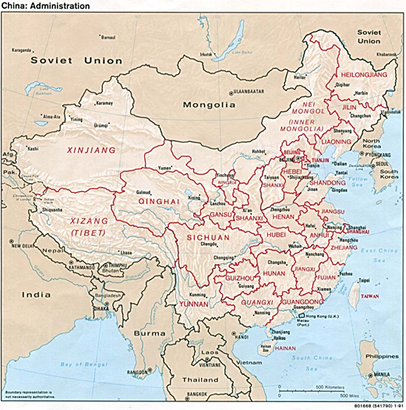 |
| courtesy of University of Texas Libraries |
Western China: Xinjiang Province, and the Central Asian States: Russia, Kazakhstan, Kyrgystan, Tajikistan and Uzbekistan. The actual conflict has occurred in (what is considered) China, although scuffles have broken out near or on the Western border mainly with Kazakhstan but also Kyrgystan and Tajikistan as well. Also, it is important to remember that in discussing the connection between Chinese economic interests and the war on terror, Afghanistan does share a small border with Western China.
5. Actors: Han Chinese, People's Republic of China, Ethnic Uyghur People
Actors
Sovereign Actors: Government of the People’s Republic of China, Han Chinese
citizens
Non-Sovereign Actors: Uyghur people (of Turkic Muslim descent) While the Chinese claim the Uyghurs are part of China, the Uyghurs consider themselves a separate national identity.

Source Problem
Looking at direct causal linkages, the environmental conflict present alongside
the ethnic conflict taking place in Xinjiang is a problem of source. The negative
impacts of the repeated and invasive search for oil are only compounded by the
fact that the benefits the area could potentially hope to see are lost as the
oil is taken out of the region and devoted to development of eastern China.
What makes the sacrifice of ethnic culture, language and political autonomy
in the pursuit of economic development seem perhaps more in vain is the fact
that China, with 9% economic growth yearly and the world’s second largest
consumer of oil, China has also continued to develop oil projects outside its
national borders in order to satisfy a need which may increase by as much as
7% this year over last(1). When 40% of China’s oil comes from imports
and China is making deals to develop oil fields in Iran, why has the region
of Xinjiang been so exploited when, according to some analysts, the actual amount
of oil in the area is far less than originally claimed, and far less than could
be found else where?
According to the list of potential source problems, this case study could be
placed under habitat loss for the simple reason that the extracting
of oil is compromising or even destroying the Uyghurs’ livelihood and
essentially their living conditions. Beyond that, however, if given the choice,
I would categorize this study simple as ‘oil’. That simple term
encompasses not only the desire for oil but also the side effects that come
with it. In China, economic growth is at the forefront of most policy decisions
and as such, the search for oil, a driving force behind economic growth, is
placed above environmental concerns or implementation of environmental protections.
The oil that is exploited from the region serves to fuel environmental degradation
in other, more developed, parts of China.
(1)China-Iran Energy Talks Complicate Nuclear Standoff. The Wall Street Journal.
February 17, 2006.
Dry, Cool (Winter) Hot (Summer) Desolate peaks vs. Arable Land
Xinjiang is a remote province and sparsely populated. It is made up of vast
deserts which contribute to a climate of very cold winters and very hot summers.
It’s an area of low humidity with more consistent patterns of rain as
opposed to a concentrated rainy season.
Xinjiang accounts for more than one sixth of China’s total territory and
a quarter of its boundary length. The provinces lowest point is 155 meters below
sea level and it’s highest is 8611 meters above sea level. More importantly,
the borders of Xinjiang include the point of land remotest from the sea which
is 1,645 miles from the nearest coastline. Several of its borders are marked
by mountain ranges contributing to the relative seclusion of the region, making
it rather difficult to access by land. Because of its geography and climate,
Xinjiang is well suited for producing fruits especially grapes and melons, and
other commodities such as wheat, silk and cotton. However, none of these products
has the power or value of the natural minerals and oil present in the region.
According to China’s estimates, Petroleum reserves have reached 20.9 billion
tons (30% of the petroleum on land in China)(CIA World Factbook)
Nation A impacts Nation A
The Act and Harm sites are primarily the same: China. However, there have been a few exceptions as to the locations in China. In early 1997, following the uprising in Yining (i.e. Gulja) in Xinjiang province (as mentioned above) there have been several bombs detonated on buses in Beijing, reportedly an act carried out by Uyghur Muslim separatists. (Though authorities originally denied the act as that of ethnic separatists, their actions proved otherwise, they began to carry out such orders as restricting religious worship activities (MacKinnon).) Perhaps this indicates the potential for the conflict to reach beyond internal (provincial) borders and maybe even international borders if Xinjiang were to further engage activists and/or separatist extremists in Central Asian territories.
| Chinese Population Distribution According to Linguistic Groups |
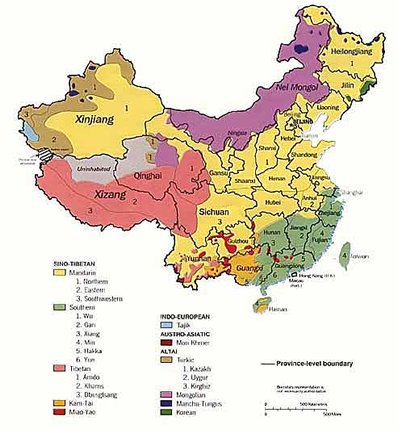 |
| courtesy of The General Libraries at University of Texas Austin |
Uyghurs make up 8 million of Xinjiang’s 17 million inhabitants. In 1949, Han Chinese made up 6.3% of Xinjiang’s population compared to 38% today (See map on Chinese language disbursement: In Xinjiang, the bright yellow represents Mandarin speakers (Han Chinese) and the tan represents speakers of Turkic languages (including Uyghur) (Lawrence). Not only has the composition of the population in Xinjiang changed but the quantity has changed as well. The oil reserves have produced an influx of people moving to the region for the wrong reasons. Many Han Chinese, who otherwise would not have gone (or subjected themselves to such an extreme climate) have either volunteered or were sent specifically to exploit the area’s natural resources. Not only does this deplete the resources themselves, it adds excessive pressure and strain on the local economy and the natural resources available for day to day living. (i.e. sacrificing agricultural land for urban development.) Therefore, to expound upon how this case was categorized earlier, it is not just the extraction of oil that is important but the unnecessary, extreme depletion of available resources and a loss of habitat (CIA World Factbook).

The conflict exists between two ethnic groups within Chinese borders.
As with most conflicts that happen internally in China, there is a great degree
of conflicting information. Additionally, it is important to clarify that though
the single incident in Yining (Gulja) has been highlighted, the overarching
conflict between the ethnic Uyghurs and the Han Chinese spans many incidents
of resistance and far more casualties.
The conflict originated over the Uyghur people's desire for political and religious
independence from the Han Chinese. With this desire for independence, came the
struggle for natural resources and local economic sustainability. The exploitation
of local oil reserves exacerbated ethnic differences and helped fuel the conflict.
Specifically in regards to what happened in Yining in February of 1997, the
numbers of casualties and deaths are estimates at best. Most reports (including
Chinese officials’ numbers) range anywhere from nine to twenty dead and
hundreds injured. Unofficial witness accounts have claimed anywhere from 30
to 100 to 400 were injured or killed (1). Other sources simply state that hundreds
joined the demonstrations that day and when fighting broke out a ‘number
of civilians and police officers were killed’. According to still other
reports, prior estimates failed to take into account the number of those arrested
and subsequently tortured in custody, or those who remain unaccounted for (Tyler,
167-172)(2). Following the incident, and as a direct result of it, Amnesty International
asserts that 210 death sentences were subsequently handed down and at least
190 carried out.
(1) Some have given accounts that stated 10-20 separatists were secretly executed
fueling the uprising giving rise to incalculable numbers of death and injuries
(Oasis Identities, 100)
(2)There were wide reports of torture by subjecting the prisoners to freezing
temperatures in public gathering places where many suffered frostbite, amputated
limbs or even death. (Amnesty International)
10. Level of Conflict: Low
The level of the intrastate (civil) conflict is low. The small, localized, struggles
were quickly and forcefully contained and put down by local Chinese enforcement.
(Prior incidents reporting few casualties: Khotan rising, Dec. 1954; Baren county,
April 1990; Yining (first disturbances) April 1995; Aksu county, Feb-April 1996.)
General Estimate: 30 people killed, at least 100 severely injured

The core of the environmental conflict ultimately rests over China’s
(or the Chinese government’s) access to oil in the Xinjiang region (the
Direct environmental-conflict link). However, a second tier exists within the
conflict over the ‘side-effects’ that the Uyghur population is now
having to deal with as a result, not only with the decline in oil resources,
but also the environmental degradation that has accompanied the influx of the
population.
Xinjiang is known for its agricultural land and appropriate climate for producing
fruits, especially grapes, and other seasonal products. However, development
(land development) has threatened the availability and richness of the land,
somewhat paralyzing the region economically as they are unable to adequately
compensate for lost sources of revenue. This growing scarcity of resources is
an indirect environment-conflict link.
The situation is ‘Sub-state’ in that the conflict over the strategic interests of oil are between two ethnic groups within China. Both the Chinese (Han) and Uyghur populations ultimately want control over the exploration and exploitation of the oil reserves located in Xinjiang. This same situation could also be viewed as a potential regional conflict because the surrounding Central Asian states not only may develop an interest in the oil (though oil suppliers are plentiful in the Middle East, Xinjiang, China does represent a geographically convenient location for importing oil to many of those countries and some have made agreements to allow China to come in and develope oil drilling sites for export back to China (ex: Kazakhstan)) parts of the populations in those Asian states such as Tajikistan, Kyrgyzstan and Kazahkstan have Uyghur populations as well and so there is a personal/ethnic tie or desire in seeing or supporting the development of an autonomous Uyghur state.
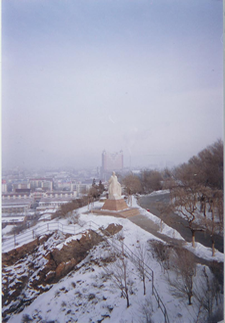 |
Winter in Urumqi |
Given that the outcome of the dispute is highly dependent upon one’s position within the conflict, this situation is even more complicated in that the description or categorization of this problem depends upon who you ask within the decision-making body (The Chinese government in this case) Some Chinese officials will say the situation in Xinjiang is under control or they will deny the severity (or existence) of the problem to begin with. However, other members within the party will hint at the greater complexity of the problem. They will acknowledge that ethnic clashes still continue and may even intensify due to the increasing importance of oil in the region and increasing awareness of the conflict both within China and internationally.
The conflict has been categorized as a stalemate because though China insists it has controlled the situation, Uyghurs in the region would say the government has managed to suppress the disturbances but only temporarily and that in fact the underlying problems are still very real and very deep.
The imposition of Chinese rule over the largely Muslim region continues to this day in all aspects of life for the Uyghur people. For example, just recently the government announced a plan to impose tougher birth control measures on the Uyghurs which Chinese officials claim will stem the population size which they say is beginning to cancel out the improvements attained through economic development (though most of the population in Xinjiang today is Han Chinese). However, the Uyghur people see this as just another example of excessive Chinese authority in the region which, in the past has led to vast human rights violations(1).
This conflict in Western China is also quickly gaining worldwide attention as several Uyghurs who have been detained at the U.S. Guantanamo Bay prison for being possible enemy combatants in 2002 are petitioning to be released. The courts have ruled that the prisoners were detained illegally but the courts lack the power to release them (unable to overrule the President). More specifically related to the conflict at hand, the Uyghurs are seeking release and asylum in the US as they have stated that they will likely be persecuted if/when they return to China (2).
These recent cases are evidence that the ethnic conflict between the Chinese government and the Uyghur population in Xinjiang is still very much alive. The environmental aspects of economic development continue to play an important role not only directly (as pertaining to oil resources) but also indirectly as population management becomes a more critical issue.
(1) Bodeen, Christopher. More Birth Control Sought in China Region. The Washington Post online. February 17, 2006.
(2) Leonnig, Carol D. Chinese Detainees’ Lawyers Will Take Case to High
Court. The Washington Post. January 17, 2006.

Separatism
Separatism in Mindanao, Philippines Armed separatist movement began in the early 1970s. Islamic rebel groups engaged in armed conflict with government forces for independence. Tensions exist over the exploitation of the island’s resources and economic disparity.
The Acehnese Resistance Movement and Exxon Mobil The resistance movement in the province Aceh began as a religious movement, but acquired a different tone once Mobil Oil Indonesia (MOI) began to exploit the oil and natural gas deposits there.
The Biafran War After gaining independence from Nigeria, one of three ethnic groups in the region wanted individual independence. This was refused by the remaining groups because of the wealth of oil reserves at stake in the region and their desire to maintain access to them.
Ethnic Conflict and the Environment
Civil War in the Sudan: Resources or Religion? The civil war can not only be characterized as religious, ethnic and regional conflicts but economic as well. Deterioration of the ecological system and scarcity of resources is quickly intensifying the situation.
KALIMAN After decades of ethnic and religious conflict in West Kalimantan, the problem has been further complicated by the government which has granted deforestation rights to cultivate palm oil contributing to the destruction of the rainforest and the local tribes’ way of life.
Yadana Gas Pipeline in Burma The joint venture has drawn criticism from both inside and outside of Burma alleging that the deal was made with a government with massive human rights violations and a record of environmental degradation.
Thai and Burmese Timber Trade The growing timber trade has left the peoples of the region to suffer under state sanctioned human rights abuses and the loss of vital environmental resources which their livelihood and tribal practices depend on.
Exploitation of Environmental Resources
JAYAMINE Island of New Guinea, territory of Indonesia, people have suffered at the hands of the military over protests against copper mining operations. Opposition against Indonesia control has existed for several decades now as the indigenous peoples are racially and ethnically different from Indonesians.
Spratly Islands Dispute Control of the Spratly Islands and the various natural resources available there, has been contended by China and several of its neighbors. With China searching for energy resources, it aims to impose its control over neighboring territories rich in oil, gas and other minerals.
OGONIOIL The Ogonis, an ethnic group in the Delta region (Nigeria), have protested that Shell's oil production has not only devastated the local environment, but has destroyed the economic viability of the region for local farmers and producers. The Nigerian Federal Government has also been accused of failing to protect the environment harming protestors.
Bodeen, Christopher. More Birth Control Sought in China Region. The Washington Post online. February 17, 2006.
China-Iran Energy Talks Complicate Nuclear Standoff. The Wall Street
Journal. February 17, 2006.
Dillon, Michael, Xinjiang—China’s Muslim Far Northwest.
Routledge Curzon, New York. 2004.
Lawrence, Susan V. China: Where Beijing Fears Kosovo. Xinjiang Issue,
September 7, 2000 Far Eastern Economic Review.
Leonnig, Carol D. Chinese Detainees’ Lawyers Will Take Case to High
Court. The Washington Post. January 17, 2006.
MacKinnon, Rebecca. CNN Correspondent. Does China have ethnic unity? Violence
indicates 'no;' leaders say 'yes' April 4, 1997.
Tyler, Christian. Wild West China. Rutgers University Press, New Jersey,
2004.
Rudelson, Justin Jon. Oasis Identities. Columbia University Press,
New York, 1997.
Starr, Frederick. Xinjiang: China’s Muslim Borderland. M.E. Sharpe,
New York, 2004.
Human Rights Watch publication: Devastating Blows: Religious Repression
of Uighurs in Xinjiang http://hrw.org/reports/2005/china0405/index.htm.
New York, 2004.
Xinhua General New Service. Xinjiang expected to be new relief for China’s
energy resource supply. Urumqi, Xinjiang, China. June 1, 2004.
Xinhua News Agency, China Exclusive: Oil/gas supply line being built along
ancient Silk Road in NW China. Urumqi, Xinjiang, China. September 16, 2005.
United Press International, Outside View: China’s Muslims Muazzam
Gill. May 7, 2004.
